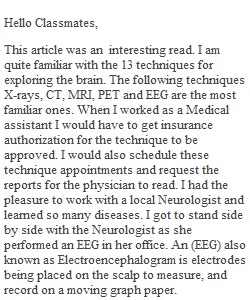


Q Class Discussion - What We'll Learn About the Brain in the Next Century In a regular Discussion, I have you work in your groups and usually only comment in the gradebook. In a Class Discussion, the whole class takes part and I will probably comment as well. In the two part article "Unlocking the Secrets of the Brain" found (Part 1) and (Part 2), different brain imaging techniques are explored. Even though we have learned much about brain function and development from the different brain imaging techniques (CAT, PET, MRI, fMRI, and SPECT), there are still limitations on what we can detect using these methods. Neuroengineer Sam Rodriques looks to the potential advances we may make in the next century. The two parts of "Unlocking the Secrets of the Brain" describe 13 techniques for exploring the brain. Describe one and give an example of how it is used. Next, explain what Sam Rodriques thinks we will be able to do in the future and how it will be better than our current methods. Your response should be 250-300 words. Find two students who described a different technique and reply to them in 75-100 words. Note: Click the options button in the upper right corner to see the rubric for this exercise.
View Related Questions